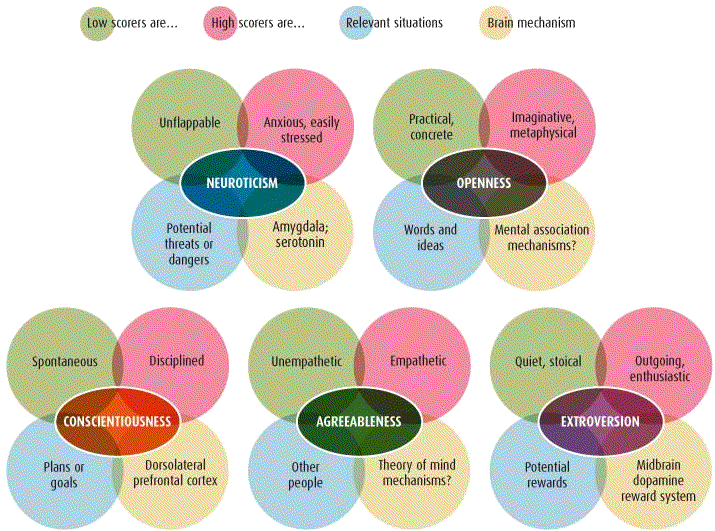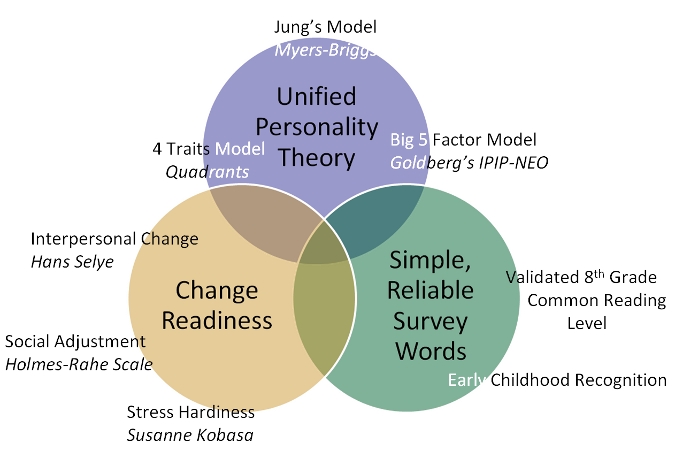
- •Theoretical review
- •Personality in organizational context
- •Overview of Personality and Traits Theories
- •1. Carl Jung and the Myers-Briggs
- •2. Hans Eysenck
- •3. The Big Five Personality Traits
- •Practical aspects of Personality and Traits Theories
- •Hiring Process
- •Self-Assessment Validity
- •Career Assessment
- •Future Behavior Predictions
- •Practical review
- •Kazakhstan profile: culture, mentality, and national characteristics
2. Hans Eysenck
Hans Eysenck was the first psychologist to make this trait or temperament business into something more mathematical. He gave long lists of adjectives to hundreds of thousands of people and used a special statistics called factor analysis to figure out what factors - trait dimensions - carry the most weight. He took the results of this work and created a test called the Eysenck Personality Questionnaire (EPQ).
Instead of making these traits either or, like Jung did, he saw them as dimensions. His first trait dimension was, like Jung, extraversion-introversion. But rather than say you were one or the other (an I or an E), he gave you a score on extraversion-introversion. A low score meant you were introverted, a high score was more extraverted. Of course, this meant you could be halfway in-between, as in fact most people are.
His second trait dimension he called neuroticism. If you scored high on this scale, that meant you tended to be a very nervous, emotional sort of person. While it doesn't mean you are necessarily a neurotic, it does mean you are more likely to develop neurotic problems such as phobias, obsessions, compulsions, and depression than someone who scores low. Low neuroticism is nowadays often called emotional stability.
The third dimension is called psychoticism. He added this later in his research, after he had gotten more data from people who were in mental institutions. As the name implies, these are people with tendencies to psychosis, meaning that they are more likely to have problems dealing with reality. Psychotic people sometimes have hallucinations and often have delusions such as odd beliefs about being watched, perhaps by the CIA or even by creatures from other planets. A middle score on psychoticism might mean that you are a bit eccentric or that you take risks that other people aren't as likely to take. A low score means that you are pretty normal in this regard.
Eysenck's research gets a great deal of respect, and most psychologists see his theory as on the right track.
3. The Big Five Personality Traits
More recently, a number of researchers have been using the latest in computer technology to redo the work that Eysenck and other earlier researchers did in far more laborious ways. This has led to what is known as the "big five" or the "five factors" theory.
The first dimension is, again, extraversion-introversion. Different jobs require different levels of extraversion. A high level of extraversion may be useful for jobs that require a great deal of interaction with other people, like public relations, teaching, and sales. Positions that are more focused on working independently and alone may be more suited to individuals with a lower level of extraversion.
The second is usually called emotional stability, and is simply the reverse of Eysenck's neuroticism. A person who has a high level of emotional stability is preferred in most professions because they have more control over their emotions at work. Employees with low emotional stability may be more easily distracted from their work, by deadlines, personal situations, and pressure.
The third is called agreeableness. A high score means that you tend to be friendly and accommodating being a nice person. If you score low, you are likely to be more idiosyncratic and have trouble getting along with people. This is not entirely negative: agreeable people often get their nice reputation by conforming and compromising on their principles, while non-agreeable people are more likely to stick to what they think is right even if it's unpopular. Then again, some are just plain disagreeable. Agreeableness is an obvious advantage for building teams and maintaining harmony on the work floor. It’s a fact that agreeable people are more likeable than disagreeable people. On the other hand, agreeableness may not be useful in some occupational situations that require difficult or objective decisions.
The fourth is conscientiousness. This parallels closely with Jung's judging-perceiving. Conscientiousness is about how a person controls, regulates, and directs their impulses. Individuals with a high level of conscientiousness on a career test are good at formulating long-range goals, organizing and planning routes to these goals, and working consistently to achieve them. Score low on conscientiousness and that probably means you tend to slack off on your work, rarely worry about deadlines or neatness, and are more interested in taking it easy.
The fifth has come with several different labels, such as culture, openness to experience, or just openness. Individuals with a high level of openness have a general appreciation for unusual ideas and art. They are usually imaginative, rather than practical. Being creative, curious, open to new and different ideas, and in touch with their feelings are all characteristics of these people. If you score high on openness, you are more likely to enjoy cultural pursuits such as art, music, and dance. You are more likely to go to museums, the symphony, and the ballet. You are more likely to want to travel to exotic countries and meet people different from yourself. Individuals who score lower in openness on a career test are generally more closed-off, resistant to change, and analytical. They are close-minded, literal and enjoy having a routine. If you score low, you are more likely to seek out the McDonalds, even when you are in Paris or Bangkok. Having a high level of openness is important in jobs that require creative thinking and a flexible attitude. Jobs such as advertising, research and other artistic occupations all benefit from high openness. A person who scores low in openness on a career test may excel in jobs that involve routine work and do not require creativity.

These five have stood up so well to research that I suspect most psychologists today accept them, at least until something even better comes along. It is also becoming clear that these are in fact strongly influenced by genetics. In other words, you are born with at least the general outline of your personality traits already laid out for you. That doesn't mean you can't change your abilities, it just means that it is less likely and more difficult.
All abovementioned personality traits theories are logically correlated to some extent. Each of them cover some part of the other theory, dividing them into psychological, or rather perceptual dimensions and complement the theory suggested by the rest. The thing is that newer ones, e.g. Big Five Personality Traits theory, are more complete and better structured. They explain and cover more dimensions of personality.

